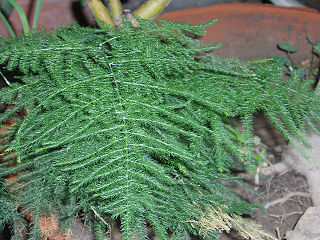
Asparagus is a genus of flowering plants in the family Asparagaceae, subfamily Asparagoideae. It comprises up to 300 species. Most are evergreen long-lived perennial plants growing from the understory as lianas, bushes or climbing plants. The best-known species is the edible Asparagus officinalis, commonly referred to as just asparagus. Some other members of the genus, such as Asparagus densiflorus, are grown as ornamental plants.

Agonis flexuosa is a species of tree that grows in the southwest of Western Australia. It is easily the most common of the Agonis species, and is one of the most recognisable trees of Western Australia, being commonly grown in parks and on road verges in Perth.

Acacia cyclops, commonly known as coastal wattle, cyclops wattle, one-eyed wattle, red-eyed wattle, redwreath acacia, western coastal wattle, rooikrans, rooikrans acacia, is a coastal shrub or small tree in the family Fabaceae. Native to Australia, it is distributed along the west coast of Western Australia as far north as Leeman, and along the south coast into South Australia. The Noongar peoples of Western Australia know the plant as wilyawa or woolya wah.

Astartea is a genus of flowering plants in the myrtle family, Myrtaceae. The genus is endemic to southwestern Western Australia. The genus name was inspired by Astarte, the Greek name for the goddess Ishtar.

Acacia extensa, commonly known as wiry wattle, is an erect shrub that is native to the South West corner of Western Australia. This particular species is resistant to dieback.
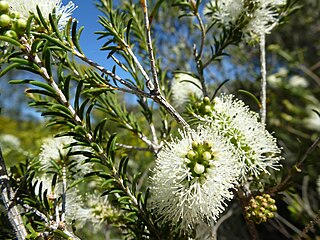
Melaleuca rhaphiophylla, commonly known as swamp paperbark is a plant in the myrtle family, Myrtaceae and is endemic to the south west of Western Australia. It has narrow, needle-like leaves and profuse spikes of white or yellowish flowers at variable times throughout the year. As its common name suggests, it is usually found in salt marshes, or swamps or along watercourses and occurs over wide areas of the south-west.

Boronia molloyae, commonly called the tall boronia, is a plant in the citrus family that is endemic to coastal regions in the south-west of Western Australia. It is a shrub with pinnate leaves that mostly have between three and seven leaflets, and deep rose pink, four-petalled flowers. It usually grows along streams in sandy soil.

Drosera gigantea, the giant sundew, is an erect perennial tuberous species in the carnivorous plant genus Drosera that is endemic to Western Australia. It grows in sandy soils at the margins of swamps and near granite outcrops along the Western Australian coast from Albany north to just south of Geraldton. D. gigantea produces small shield-shaped leaves along many lateral branches that look like a small tree. Individual plants can grow up to 0.2–1 m (0.7–3.3 ft) tall. Because of its tall, tree-like form, it is considered one of the largest Drosera species. It is also easily cultivated and enjoys damp, humid conditions often provided in greenhouses. White flowers emerge from August to November. The red tubers of this species can grow to be 3.8 cm (1.5 in) in diameter and may be a metre below ground.
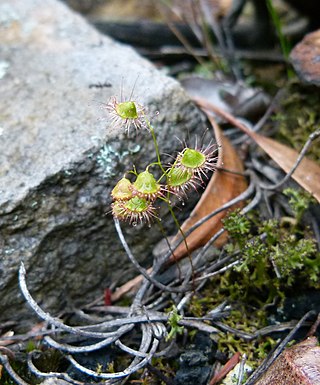
Drosera huegelii, the bold sundew, is an erect perennial tuberous species in the carnivorous plant genus Drosera that is endemic to Western Australia. It grows in sandy soils in winter-wet depressions and margins of swamps and occurs along the south-west coast of Australia. D. huegelii produces small, bell-shaped leaves along an erect stem that can be 10–50 cm (4–20 in) tall. White to cream-coloured flowers emerge from June to September.

Caladenia arenicola, commonly known as the carousel spider orchid, is a plant in the orchid family Orchidaceae and is endemic to the south-west of Western Australia. It has a single erect, hairy leaf and up to three red, white and green flowers on a flowering stem up to 60 cm (20 in) high. It is a common species on the Swan Coastal Plain, where it grows in sandy soil under trees.
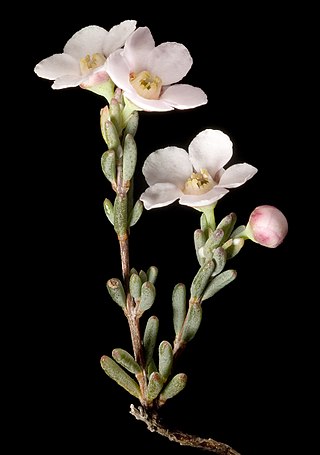
Cyathostemon is a genus of flowering plants in the myrtle family, Myrtaceae. The genus is endemic to southwestern Western Australia. The genus was first described by Nikolai Turczaninow in 1852. Species include:

Acacia anceps, commonly known as Port Lincoln wattle or the two edged wattle, is a shrub belonging to the genus Acacia and the subgenus Phyllodineae.

Acacia maxwellii is a shrub belonging to the genus Acacia and the subgenus Phyllodineae that is endemic to south western Australia.

Cyathostemon ambiguus is a member of the family Myrtaceae endemic to Western Australia.
Cyathostemon divaricatus is a member of the family Myrtaceae endemic to Western Australia.
Cyathostemon verrucosus is a member of the family Myrtaceae endemic to Western Australia.

Hypocalymma cordifolium is a member of the family Myrtaceae. It is endemic to Western Australia.
Stirlingia anethifolia is a shrub endemic to Western Australia.
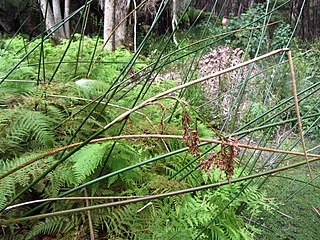
Baumea articulata, commonly known as jointed rush, is a sedge in the sedge family, Cyperaceae, that is native to Western Australia. The grass-like plant is rhizomatous and perennial, it typically grows to a height of 1 to 2.6 metres. It blooms between September and December producing red-brown flowers on pendulous inflorescences.
Sorocephalus tenuifolius, the diminutive clusterhead, is a flowering shrub that belongs to the genus Sorocephalus and forms part of the Fynbos. The plant is endemic to the Western Cape where it occurs in the Palmiet River valley in the Kogelberg. The plant was considered extinct in 1987 but a new population was discovered.
















